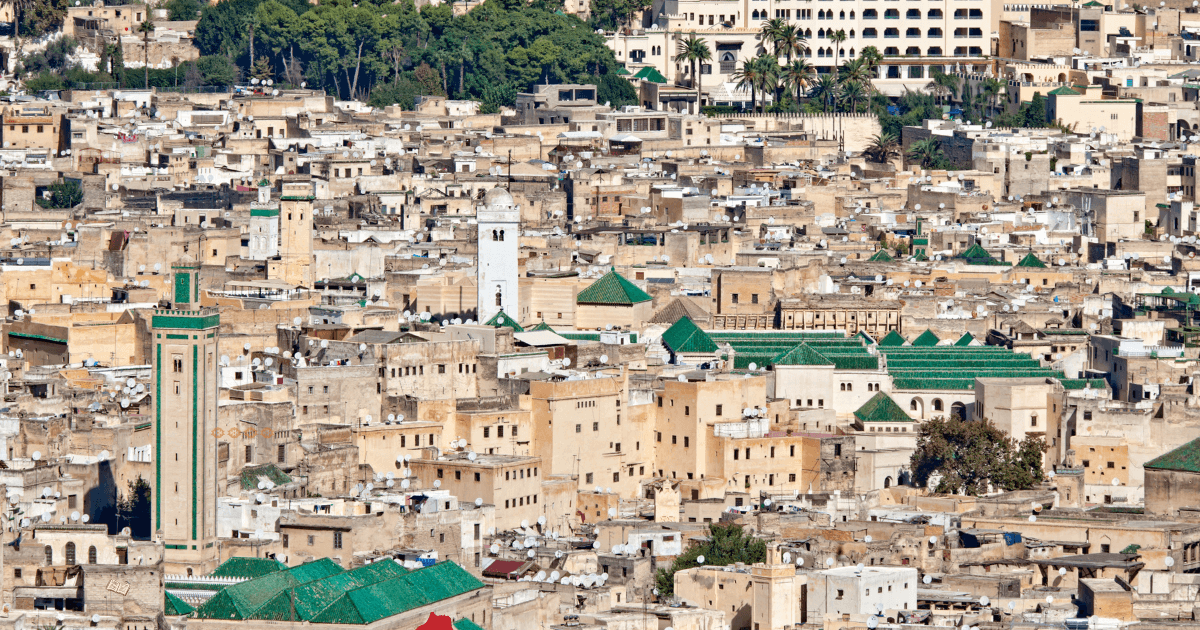People frequently urge others to visit Fez City. It is one of the world’s most romantic locations, as well as one of the most ideal communities for alternative living. An additional set of characteristics that distinguish this municipality are its historic landmarks, vibrant culture, and extensive past.
Why is it called Fez?
We have derived an Arabic word from the term “fez.” The term “fa’as” is defined as a bifurcation. There is a belief that “Idris I” employed this instrument in order to devise a plan for the urban layout. When “Mawla Idris” and his army fled the Abbasids’ oppression into Morocco, he used an axe to designate the landing site and determine the precise location to begin the city’s construction. Prior to 1925, Fez served as the metropolis of modern Morocco. It currently serves as the administrative center of the Fès-Meknès region. Its three sections are the old city, Fes Al Bali, and Fes Jdid, where the French constructed the Ville Nouvelle.
The history of Fez:
FES is the second-largest metropolis in Morocco. In 789, Idris I initiated the construction of Fes along the Jawhar Riverbanks. Idris I prohibited Arab families from residing in Kairouan and expelled Andalusians from Cordoba for disobeying the Umayyads of Andalusia, both of whom settled in the city, thereby contributing to its Arabic flavor.Many people view Fes as a pivotal time in Moroccan history. Al Qarawiyyn emerged as the first neighborhood in Fes, compelling Arab families to abandon their residences. The Al Andalusians, forced to flee Andalusia, established their residences in the Al Andalusians neighborhood.
Jewish individuals resided in the Al Mallah neighborhood.After the death of “Idris I,” the construction of the second city took place on the left bank of the river. Yusuf Ibn Tashfin’s arrival led to the partition of the city. Under his rule as king of the Almoravids, he commanded the consolidation of the two municipalities. Fes had developed into a scientific, cultural, religious, and military capital. Therefore, we regard him as the second progenitor of Fes.
Principal sights in Fez:
Fez is gaining popularity as a tourist destination, and an increasing number of non-Moroccans are renovating traditional houses in the medina with the intention of purchasing them as second residences.
These are the most significant landmarks in the city of Fez:
The sales of AL MOHAD The city is renowned for its intriguing architectural entrances and structures. The Al Naser Al Mowahed Caliphate-era Fez Al Bali Walls are among the most significant landmarks. Presently, these Al Mohad walls continue to manifest the form of Fes Al Bali. The destruction of the Idrisid city fortifications led to the erection of these walls. They traverse considerably more territory. The World Heritage Site classifies both the ramparts and their environs as components.
1. The Al-Attarine Madrasa
The Al-Attarine Madrasa is located north of the Al Qarawiyyin mosque in the city of Fes. Despite its diminutive size, it is among the most impressive educational institutions in the Arabic world. Due to its intricate embellishments, it is considered a rare architectural masterpiece. The Marinid monarch, Uthman II Abu Said, constructed it.The school’s name derives from the spice and aromatic market known as the Souk al-Attarine. TThe school has a water fountain in its open courtyard, which is also home to a square prayer hall and classrooms for both students and faculty.Moroccan artisans decorate the walls with the open vessel, which serves as an example of the diverse styles they use to adorn their landmarks. Depicting the madrasa with various materials, particularly clay mosaics known as glazes and vessels, demonstrates a considerable degree of expertise.
2.QARAWIYYIN UNIVERSITY
QARAWIYYIN UNIVERSITY In 859, the University of Al-Qarawiyyin was established. The perception among the general public is that the university is the oldest operational university in the world. In accordance with Guinness and UNISCO world records, it was also the first institution to award degrees. The university’s curriculum primarily consists of courses in Islamic, religious, and legal studies.
3. Above the Tower:
The Saadians built this fortress in 1582, to the north of Fez Al Bali. Portuguese villas dating back to the 1600s influenced the tower’s design. The Museum of Weapons is currently located here.
4. IBN Danaan Synagogue
The 17th century saw the completion of the IBN Danaan Synagogue in Fes, Morocco. Rashid ben Ali al-Sharif, the monarch of Morocco, constructed the temple to stimulate commerce in the city. He led the Jews from the Mediterranean Atlas corner of Ait Ishaq and instructed Rabbi Maimon Poseidan, a respected individual in Ait Ishaq, to construct the synagogue.Previously, the synagogue was one of the many inner fortifications of Fes.
The entrance to the synagogue is a simple aperture that bears resemblance to the entrances to adjacent residences. A flight of stairs greets one upon immediate entry, ascending to the lofty, rectangular chamber of the synagogue. Stone and stucco form its construction. A wooden beam and paint adorn the roof, while a diminutive window embedded in the wall provides illumination for the space. Crafted from wood, the large Torah Ark is a cupboard that spans the entire breadth of a wall.
The wall above is adorned with exquisite carving plasterwork. Intensely carved arches adorn a wooden barrier that separates the elevated area adjacent to the Torah Ark from the primary prayer area. The intention was for the most influential members of the congregation to sit in that location. In Jewish synagogues, the bimah serves as a raised platform for reading the Torah during services. The room leads to the bimah, a small platform dangling from the raised area. A wrought iron canopy adorned the wooden bimah, showcasing floral motifs and arches in the Islamic style, culminating in a crown.




No comment